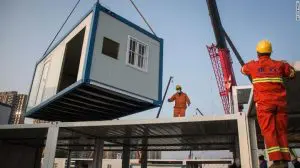
A modular section being lifted into place during the construction of Huoshenshan Hospital. Image via CNN
For years natural and man-made disasters have resulted in the widespread use of relocatable modular buildings to meet short and extended use replacement facility needs. This allows schools, government agencies, healthcare providers and commercial businesses to open and get back to operating quickly without significant delays. A case in point was an entire middle and high school campus that Ramtech built for West ISD after the massive fertilizer plant explosion destroyed two of the district’s schools in April of 2013.
Now, with the current COVID-19 pandemic, modular construction has once again been brought to the forefront, with high profile projects that have helped to provide urgent care medical facilities in China and other hot spots around the globe. However the impact that modular construction has made may be changing attitudes well after the crises eases, as this article from our friends at Architizer.com point out in the ‘8 Ways COVID-19 Will Change Architecture’. It includes a strong argument for an increase in the use of modular construction.
Read about eight of these new approaches including, modular construction, that may have long lasting impacts on the way cities are designed following the COVID-19 outbreak here.
